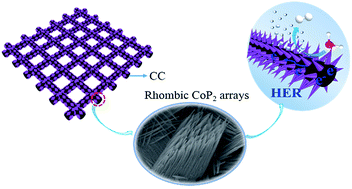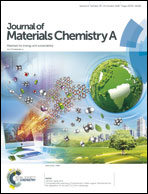Rhombic porous CoP2 nanowire arrays synthesized by alkaline etching as highly active hydrogen-evolution-reaction electrocatalysts†
Abstract
In the present work, a four-step strategy has been used to prepare rhombic arrays of porous CoP2 nanowires on carbon cloth (denoted as CoP2/CC) for an efficient hydrogen evolution reaction (HER). The four-steps involve the hydrothermal synthesis of the CoxZn1−xOHF precursor, the formation of Co2O3@ZnO through a thermal treatment, alkaline etching of ZnO and phosphorization. Specifically, the ratio of Co to Zn in the precursor affects significantly the morphology and HER performance of CoP2/CC. CoP2/CC-4 (which was obtained at the optimal Co–Zn ratio), as a self-supported and binder-free electrode, exhibits a superior catalytic performance toward HER in both acid and alkaline media. The overpotential of HER is as low as 56 mV in 0.5 M H2SO4 and 72 mV in 1 M KOH at a current density of 10 mA cm−2. Correspondingly, the Tafel slope of the electrode reaction is not larger than 67 mV dec−1 and 88 mV dec−1 in acid and alkaline solution, respectively. Furthermore, the catalyst maintained a high stability for HER. This work displays a new idea to fabricate efficient electrocatalysts for HER or other electrochemical reactions.



 Please wait while we load your content...
Please wait while we load your content...